工艺隐藏在显眼的地方
Craft Hides in Plain Sight
由专筑网姬薇薇,李韧编译
最近, Olson Kundig事务所的Jim Olson拜访了Aaron Betsky,他说,越专注,收获也越大。
A recent visit with Olson Kundig's Jim Olson showed Aaron Betsky that the more you spend, the harder it is to see the cost.
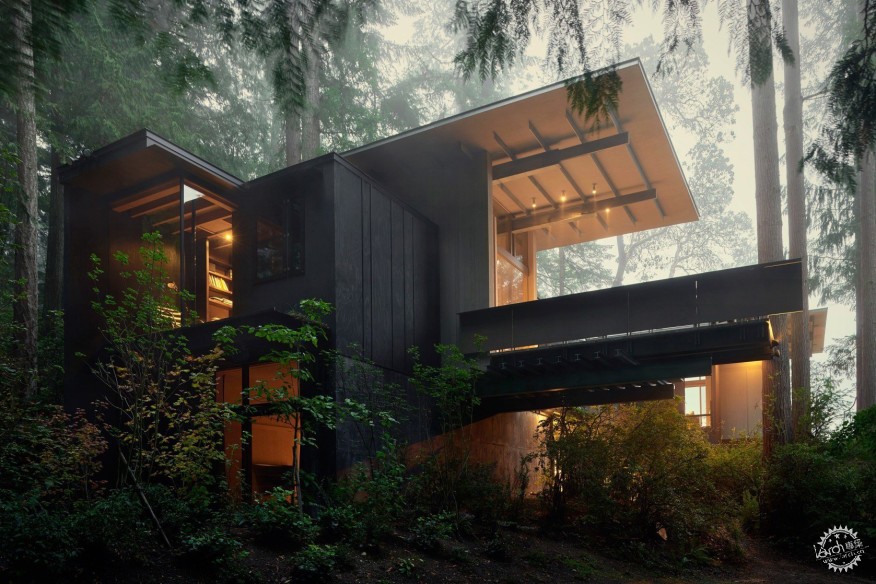
自1959年以来,Jim Olson就一直在位于西雅图普吉特湾(Puget Sound)的朗布兰奇(Longbranch)的小木屋里进行建造和改进工作/Jim Olson has been building and adding to his Cabin at Longbranch, on Puget Sound in Seattle, since 1959. courtesy Olson Kundig
我最近有幸与西雅图的建筑师Jim Olson共度了一个周末,并参观了他在过去50年里设计的一些房子。我最近总是在思考各种工艺的实用性,而这次旅行为我带来许多帮助。
专注于这些房子的工艺很容易,因为Olson正如他自己所认同的那样,在近半个世纪的时间里一直在完善同种类型的建筑。除了房子的规模、朝向,以及房屋布局的变化,项目的主要变化在于材料的使用以及建筑的细部构造。当你对这些建筑进行调查时,你可以发现他对房子的钻研已经从最基础的功能空间的探索而演变成更精致的细部构造和做法,因为一座建筑优秀与否,常常与细部设计有着紧密的联系。
I recently had the pleasure of spending a weekend with Seattle-based architect Jim Olson, FAIA, touring around some of the houses he has designed over the last 50 years. The tour helped me to ground my recent speculations on the availability and uses of craft using the work of a specific practice.
Concentrating on the craft of these houses was easier because Olson, as he himself readily admits, has been perfecting the same house type for that entire half-century period. Other than scale, orientation, and variations in the houses’ layout, the main changes from project to project are the materials used and how Olson and his team at Olson Kundig detail similar structures. As you survey the constructions, you can see how his basic notion of a house has evolved into something that is ever more finely crafted, meaning that the connections tend to dissolve and disappear the more expensive and grand the house is.
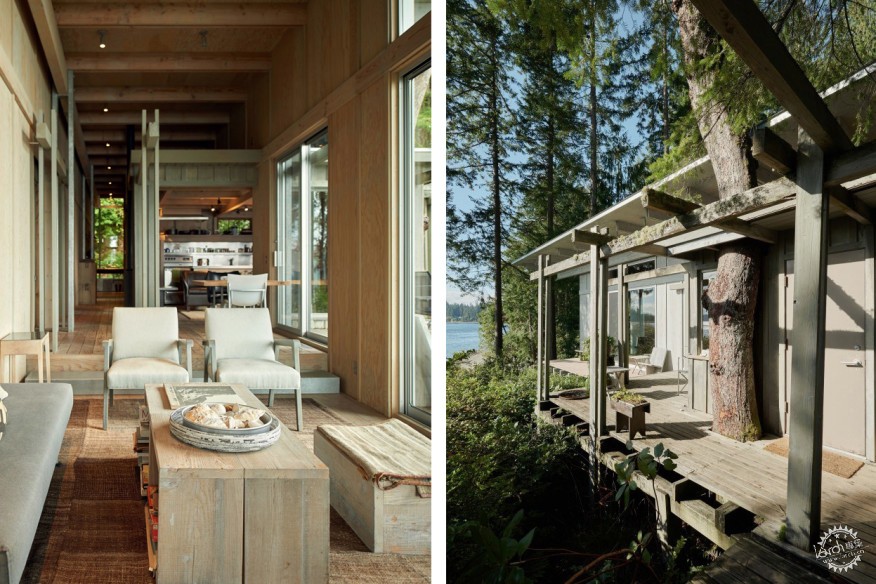
在朗布兰奇不断扩大的小屋/Inside and outside the ever-expanding Cabin at Longbranch. courtesy Olson Kundig
Olson的作品都来源于一个建筑原型,那是他50多年前在一个叫做朗布兰奇(Longbranch)的半岛上建造的小屋。这是一个简单的集装箱,他和一个木匠用木头建造,每条木板、每个细部构造都清晰可见。多年来,Olson已经对这座建筑进行了多次改造,他将原来的建筑嵌入在长序列空间里,这里运用了木头、胶合板以及局部的金属支柱,支撑着天花板上面漂浮的天窗,人们可以通过这个窗户看见外面的景色。只是最近的策略更简单,你会发现各个连接部分逐渐消失。
The touchstone for all of Olson’s work is the cabin he built more than 50 years ago on a peninsula in the Puget Sound called Longbranch. It was a simple container he and a carpenter built out of wood, each one of its slats and boards clearly visible and each connection articulated. Over the years, Olson has extended that first shelter several times, embedding the original construction in what has become a sequence of living and sleeping spaces along a long axis. Everything here is wood, plywood, and occasional metal struts that support ceilings floating above clerestories and extending towards the views. Only the most recent addition is simpler, and you can see these connections beginning to fade into the walls.
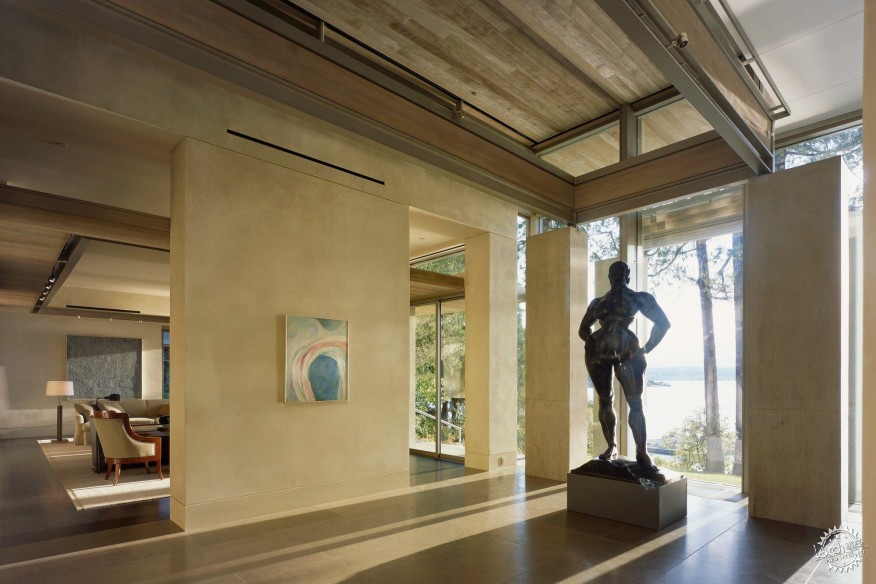
位于美国西雅图/An American Place, in Seattle. courtesy Olson Kundig
当Olson的客户不想在他们的项目上花费大量资金时,沉重的木材和金属的表现力会再次出现。在最近的城市小木屋里,建筑师为一个在朗布兰奇附近隐居的朋友设计了一个郊区的小屋,这座小屋就是一个简单的方盒子,里面有垂直的木板。一个屋顶漂浮在客厅的两侧,两边都是卧室,房屋还带有客房和服务空间。这座建筑的主要结构是钢和胶合梁,Olson和他的团队竭尽全力去展示如何使它们看起来更加契合,他们甚至把垂直柱子从中间分裂,这样那些横梁就能从屋架下方穿过,然后,建筑师在横梁的末端覆盖了金属,据说是为了防止湿气的渗透,但大多数时候,Olson说,“因为它看起来很棒”,从而强调了小屋内部的材料运用。
The expressiveness of the heavy wood and metal shows up again when Olson has clients who do not have or want to spend a great deal of money on their projects. The recent City Cabin, which the architect designed on a suburban lot for a friend who has a retreat near his in Longbranch, is a not much more than a box covered inside and out with vertical wood planks. A roof floats over that living space, which is flanked on either side by a master bedroom that is a plywood cocoon and a wing with a guest room and service spaces. The main structure is a combination of steel and glulam beams, and Olson and his team went to great lengths to show how it all fits together, even splitting the vertical posts down the middle so that those beams can slide through them while holding up the sheltering overhang of the roof. The team then capped the beams’ ends with more metal, supposedly to prevent them splitting from moisture, but mostly, as Olson says, “because it looks good,” emphasizing the play of materials in the cabin.
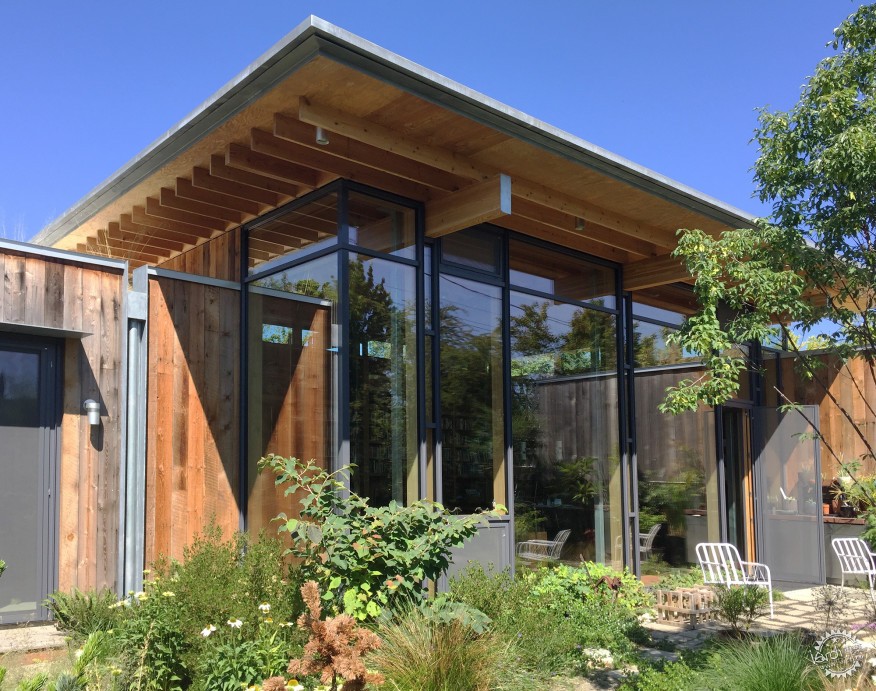
新城市小屋的外部景观/Exterior view of the new City Cabin. Aaron Betsky
我最近拜访了几个Olson的作品,其中一个在西雅图,两个在海湾地区,这些作品大部分的构造节点都被隐藏起来,相反,你所看到的是那些被打磨得闪闪发亮的平面,它们都能展示出精巧的手艺以及精细的材料。巨大的橡木层,甚至更昂贵的木材,构成了壮观的现代艺术收藏品的背景,Olson的这些做法十分吸引各种客户。当一种材料与另一种材质相遇时,你只能发现其中的细微变化,而我发现自己正凝视着材质的边缘,想弄清楚其中的各项关联,在许多精致的工艺品的背后,都有一些非常复杂的细节,那是凡人的眼睛永远看不到的部分。
加上漂浮的屋顶,光线来自未知的角落,以及Olson通过窗户所强调的巨大尺度感的延伸,这种工艺具有超凡脱俗的效果。建筑师指出其中设计的依据是,建筑的形状和颜色表达了建筑与自然的关联,而设计的本质则存在于对自然、对艺术作品的看法之中。
When you experience Olson’s more expensive houses—I recently visited one of them in Seattle and two of them in the Bay Area, but have seen others in the past—most of that expression of the meeting point of materials and the work the structure is performing disappears. What you see instead is planes that have been burnished to a luster that both attracts the hand and abstracts the material. Vast reaches of oak, and even more expensive wood, form the backdrop for the spectacular modern art collections whose owners Olson seems to attract as clients. Where one material meets another, you can discover only the smallest reveal, and I found myself peering at the edges to figure out how the whole thing was being held up. Somewhere behind the planes are some pretty complicated details which mortal eyes will never see.
Coupled with the floating roofs, the light coming from unseen sources, and the huge scale Olson emphasizes through windows that he stretches out to the proportion of a Modigliani neck, the effect of the suppression of the craft is at times otherworldly. What grounds the designs is, the architect points out, the views out to nature—its forms and colors coming alive against the elongated interiors—and the works of art that blaze against those earth-toned walls.
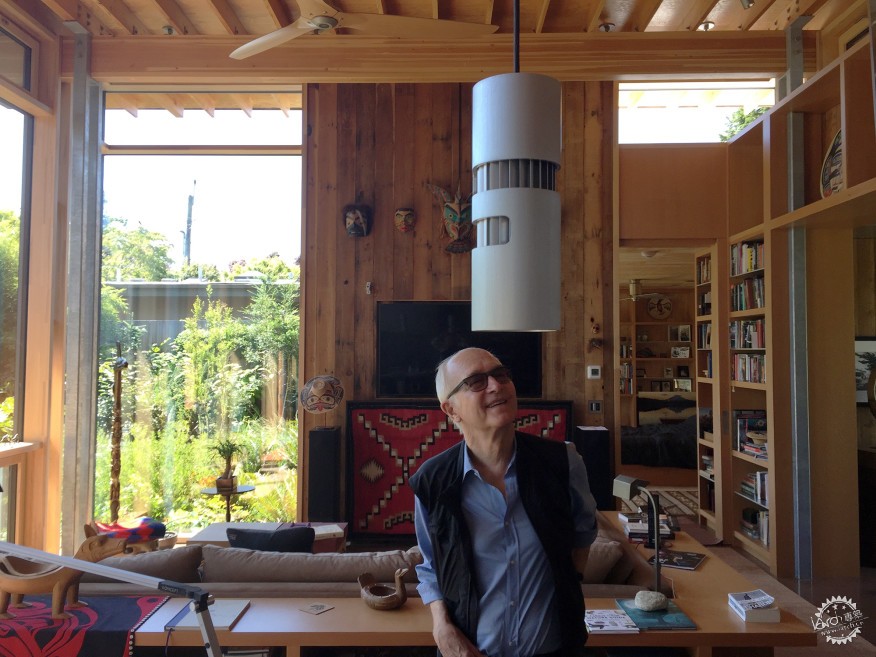
Jim Olson在新城市的小屋内/Jim Olson inside the new City Cabin. Aaron Betsky
“如果你筹集一大笔钱,我将给你很棒、很伟大的建筑,”建筑师Yoshio Taniguchi说,据报道,对于约20年前现代艺术博物馆的设计费用,FAIA花费了数十亿美元,“但如果你真的打算花费更多的钱,我将让建筑消失。”虽然他和Olson都没有达到这一目标,但后者已经朝着这个方向前进,从而把他的建筑变成自然和艺术的象征。
在我看来,最明显的是,在Olson的最好的作品里,这一工艺隐藏在朴素的视野之中。你不知道把这些细部花费了建筑师多少时间精力,也不知道这些珍贵的材料是如何使用。然而整体效果非常优雅,但这座房子也说明了工艺制品无价的原因,在所有的设计和施工中,最昂贵和最困难的技能是让人工痕迹消失。
“If you raise a lot of money, I will give you great, great architecture,” architect Yoshio Taniguchi, Hon. FAIA, is reported to have told the board of the Museum of Modern Art when he designed their billion-dollar addition almost 20 years ago, “but if you raise really a lot of money, I will make the architecture disappear.” While neither he nor Olson quite achieved that aim, the latter has gone much further towards turning his buildings into recessive stages for nature and art, as well as the people who can command the views of both.
What is also evident to me is that in Olson’s best houses the craft hides in plain sight. You don’t see how much work it took to put these places together, nor do the precious materials flaunt themselves. The effect is supremely elegant, but the houses also point to a reason why we have so much trouble truly valuing craft: The most expensive and difficult skill in all design and construction is to make the effort disappear.
关于叙述者Aaron Betsky的简介:
Aaron Betsky是一个专栏作家,他的故事每周都出现在这个网站上。他的观点和结论并不代表建筑师杂志,也不代表美国建筑师协会。
Aaron Betsky是一位评论家,著有十多本关于艺术、建筑和设计的书籍。在耶鲁大学接受培训的贝斯基曾担任过Frank o.Gehry & Associates和Hodgetts+Fung的设计师,任教于SCI-Arc,并担任第11届威尼斯国际建筑双年展(Biennale)的总监。目前,他是塔里耶森的弗兰克•劳埃德•赖特(Frank Lloyd Wright)建筑学院的院长。
Aaron Betsky is a regularly featured columnist whose stories appear on this website each week. His views and conclusions are not necessarily those of ARCHITECT magazine nor of the American Institute of Architects.
Aaron Betsky is a critic and author of more than a dozen books on art, architecture, and design. Trained at Yale, Betsky has worked as a designer for Frank O. Gehry & Associates and Hodgetts + Fung, taught at SCI-Arc, and served as the director of the 11th Venice International Architecture Biennale. He is currently the dean at the Frank Lloyd Wright School of Architecture at Taliesin and Taliesin West.
出处:本文译自www.architectmagazine.com/,转载请注明出处。
|
|
